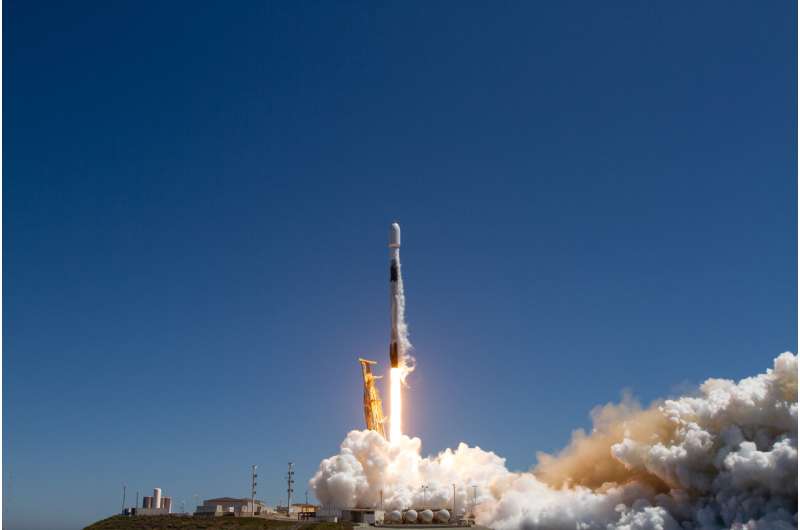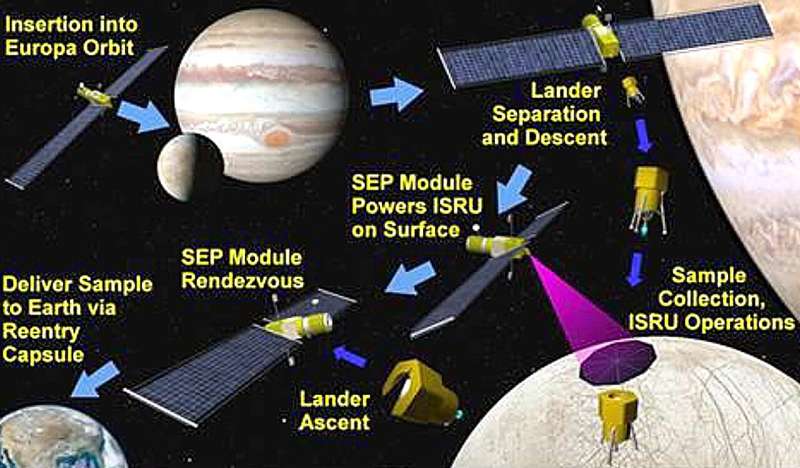
Copernical Team
SpaceX sends 22 Starlink satellites into orbit using new first stage booster
 SpaceX debuted a new Falcon 9 first stage booster as it launched a batch of Starlink satellites on Tuesday morning.
The Falcon 9 lifted off from the Cape Canaveral Space Launch Complex in Florida at about 9:20 a.m. EDT, near the end of the launch window, as weather conditions improved. The rocket was carrying 22 Starlink satellites.
Lifting off with a new first stage, the Falcon
SpaceX debuted a new Falcon 9 first stage booster as it launched a batch of Starlink satellites on Tuesday morning.
The Falcon 9 lifted off from the Cape Canaveral Space Launch Complex in Florida at about 9:20 a.m. EDT, near the end of the launch window, as weather conditions improved. The rocket was carrying 22 Starlink satellites.
Lifting off with a new first stage, the Falcon NASA CubeSats launch as commercial rideshares

A pair of CubeSats from NASA's Pathfinder Technology Demonstrator, or PTD, series lifted off on SpaceX's Transporter-11 rideshare mission at 11:56 a.m. PDT Friday, August 16, from Vandenburg Space Force Base in California.
The two small satellites, PTD-4 and PTD-R, will help advance NASA's efforts to validate novel technologies and increase small spacecraft capabilities in order to shape the future of space exploration and technology.
PTD-4 will demonstrate a high-power, low-volume deployable solar array with an integrated antenna, while PTD-R will focus on testing simultaneous ultraviolet and short-wave infrared optical sensing from space for the first time via two 85-mm aperture monolithic telescopes mounted side-by-side.
A European lander could return an ice core for a fraction of the cost of Europa Clipper

Cost is a major driving factor in the development of space exploration missions. Any new technology or trick that could lower the cost of a mission makes it much more appealing for mission planners. Therefore, much of NASA's research goes into those technologies that enable cheaper missions.
For example, a few years ago, NASA's Institute for Advanced Concepts (NIAC) supported a project by Michael VanWoerkom of ExoTerra Resource to develop a lander mission that could support a sample return from Europa. Let's examine what made that mission different from other Europa mission architectures.
The Nano Icy Moons Propellant Harvester (NIMPH) mission relies on three main advancements for one significant result: a 10x reduction in the overall mission cost. That reduced cost comes mainly from a single fact—the mission's weight has dropped below the threshold where it can be launched by an Atlas V rather than the SLS, as similar missions would require.
Sentinel-2C Satellite Prepared for September 4 Launch
 The Copernicus Sentinel-2C satellite is now fully fueled and pressurized, ready for its upcoming launch on 4 September from Europe's Spaceport in French Guiana. The satellite has been loaded with 133 kg of hydrazine, and its tanks have been pressurized with helium to 21 bars.
Sentinel-2C arrived at the Spaceport on 22 July, where it has undergone final preparations for its journey aboard a
The Copernicus Sentinel-2C satellite is now fully fueled and pressurized, ready for its upcoming launch on 4 September from Europe's Spaceport in French Guiana. The satellite has been loaded with 133 kg of hydrazine, and its tanks have been pressurized with helium to 21 bars.
Sentinel-2C arrived at the Spaceport on 22 July, where it has undergone final preparations for its journey aboard a HawkEye 360 and SFL Successfully Deploy Cluster 10 Satellites to Enhance RF Monitoring Network
 HawkEye 360 Inc., a leader in space-based radio frequency (RF) data analytics, has successfully launched its Cluster 10 satellites into orbit, expanding its constellation to 31 satellites. The deployment was achieved through the collaboration with Space Flight Laboratory (SFL) and was part of SpaceX's Transporter-11 Rideshare mission, coordinated by launch integrator Exolaunch. The mission was l
HawkEye 360 Inc., a leader in space-based radio frequency (RF) data analytics, has successfully launched its Cluster 10 satellites into orbit, expanding its constellation to 31 satellites. The deployment was achieved through the collaboration with Space Flight Laboratory (SFL) and was part of SpaceX's Transporter-11 Rideshare mission, coordinated by launch integrator Exolaunch. The mission was l York Space Systems Secures Contract for 10 Satellites in SDA's Tranche 2 Transport Layer Gamma
 York Space Systems (York), a Denver-based aerospace company known for its rapid deployment of comprehensive space mission solutions, has been awarded a new contract by the Space Development Agency (SDA) to develop and deliver 10 satellites for the Tranche 2 Transport Layer Gamma (T2TL-Gamma) of the Proliferated Warfighter Space Architecture (PWSA). These satellites, scheduled for launch in 2027,
York Space Systems (York), a Denver-based aerospace company known for its rapid deployment of comprehensive space mission solutions, has been awarded a new contract by the Space Development Agency (SDA) to develop and deliver 10 satellites for the Tranche 2 Transport Layer Gamma (T2TL-Gamma) of the Proliferated Warfighter Space Architecture (PWSA). These satellites, scheduled for launch in 2027, Tyvak Secures $254 Million Contract to Build Satellites for Space Development Agency's T2TL Gamma
 Tyvak Nano-Satellite Systems, Inc., a subsidiary of Terran Orbital Corporation (NYSE: LLAP) based in Irvine, California, has been awarded a $254 million prototype agreement by the Space Development Agency (SDA) to manufacture 10 satellites for the Tranche 2 Transport Layer (T2TL) Gamma contract.
Under this contract, Terran Orbital will be responsible for the entire lifecycle of the 10 T2TL
Tyvak Nano-Satellite Systems, Inc., a subsidiary of Terran Orbital Corporation (NYSE: LLAP) based in Irvine, California, has been awarded a $254 million prototype agreement by the Space Development Agency (SDA) to manufacture 10 satellites for the Tranche 2 Transport Layer (T2TL) Gamma contract.
Under this contract, Terran Orbital will be responsible for the entire lifecycle of the 10 T2TL US Air Force working with SandboxAQ to enhance AQNav GPS protection
 SandboxAQ has secured an SBIR Phase 2B Tactical Funding Increase (TACFI) from the U.S. Air Force (USAF) to advance its AQNav magnetic navigation (MagNav) system. This funding will allow SandboxAQ and its partner, AFWERX, to explore new configurations of the AQNav system, such as a pod-based version, for broader deployment across various aircraft platforms, including unmanned aerial systems.
SandboxAQ has secured an SBIR Phase 2B Tactical Funding Increase (TACFI) from the U.S. Air Force (USAF) to advance its AQNav magnetic navigation (MagNav) system. This funding will allow SandboxAQ and its partner, AFWERX, to explore new configurations of the AQNav system, such as a pod-based version, for broader deployment across various aircraft platforms, including unmanned aerial systems. Sateliot Advances Towards Commercialization Following Launch of Four New Satellites
 Sateliot, the company spearheading the first low-Earth orbit (LEO) nanosatellite constellation utilizing 5G NB-IoT NTN standards, has successfully added four more satellites to its constellation. This launch, part of the company's 5G NB-IoT NTN initiative, is set to enhance global coverage for Mobile Telecom Operators. The satellites were launched on Friday, August 16, at 20:18 CET, aboard a Spa
Sateliot, the company spearheading the first low-Earth orbit (LEO) nanosatellite constellation utilizing 5G NB-IoT NTN standards, has successfully added four more satellites to its constellation. This launch, part of the company's 5G NB-IoT NTN initiative, is set to enhance global coverage for Mobile Telecom Operators. The satellites were launched on Friday, August 16, at 20:18 CET, aboard a Spa Exolaunch Reaches 30th Launch Milestone with Successful Deployment of 42 Satellites on SpaceX Transporter-11
 Exolaunch, a global leader in launch mission management and satellite deployment services, has successfully deployed 42 customer satellites aboard the Transporter-11 Rideshare mission with SpaceX. The launch took place on Friday, August 16 at 11:56 PDT from Vandenberg Space Force Base in California.
This mission is particularly significant for Exolaunch as it marks the company's 30th launc
Exolaunch, a global leader in launch mission management and satellite deployment services, has successfully deployed 42 customer satellites aboard the Transporter-11 Rideshare mission with SpaceX. The launch took place on Friday, August 16 at 11:56 PDT from Vandenberg Space Force Base in California.
This mission is particularly significant for Exolaunch as it marks the company's 30th launc 